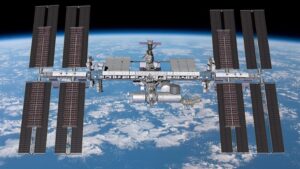The agency announced Jan. 11 it would fly the first pair of upgraded solar arrays to the station later this year on a SpaceX Dragon cargo spacecraft, stored in the spacecraft’s unpressurized trunk section. Two other pairs of the arrays will fly on later Dragon cargo missions, but NASA did not disclose a schedule for them.
The arrays will be installed on top of six of the eight existing solar arrays on the station. Doing so allows the new arrays to use the tracking and power distribution systems of the existing arrays, minimizing the amount of new equipment needed. Each array will require two spacewalks to prepare the location where the arrays will be installed, and then to do the installation itself.
That installation means the new arrays will partially shadow the old ones, covering a little more than half of each array. However, the new arrays are more efficient, producing more power than what will be lost by covering the old arrays. NASA estimates that, when all six new arrays are installed, the overall power system will generate 215 kilowatts of power, compared to 160 kilowatts the existing arrays provide.
The new arrays will use a technology called Roll Out Solar Arrays (ROSA), developed by Deployable Space Systems. The solar arrays are rolled up in a canister and then unfurled, or rolled out, once in space. The ROSA system was tested on the ISS in 2017 and is now being incorporated into other spacecraft, such as the Power and Propulsion Element of NASA’s lunar Gateway.
NASA installed the existing set of eight arrays on shuttle missions from 2000 to 2009. The performance of the arrays has been gradually degrading, as expected. The ISS Advisory Committee identified that degradation in 2018 as one issue for the long-term future of the ISS.
NASA is currently authorized to operate the ISS through 2024, although there have been several efforts in Congress to formally authorize an extension of operations through the end of the decade. The agency seeks to eventually shift to commercial space stations, although its low Earth orbit commercialization initiative has been hindered by a lack of funding, including just $17 million in fiscal year 2021 compared to its request for $150 million.
Boeing, NASA’s ISS prime contractor, is optimistic that the station can operate for years to come with the new solar arrays, as well as other work on its power system and upgrades to its communications system to increase its bandwidth.
“When it comes to game-changing research and technological development, the space station is currently hitting its full stride,” said John Mulholland, ISS vice president and program manager at Boeing, in a company statement. The various upgrades, he said, “will ensure that ISS remains an incubator and business model in the commercial space ecosystem for the coming decades.”
At a company briefing last October, Mulholland said that the new arrays, as well as work that had just been completed to replace batteries in the station’s power system, were “really foundational” to extending the life of the station. Other issues the company is monitoring include are mechanisms that wear out over time.
“As the technical teams have looked at it, they firmly believe that we haven’t reached that breaking point” where systems fail faster than they can be replaced, he said then. “We’re confident that we can go well into the next decade if the mission, from a policy perspective, gets extended.”
The solar array upgrades are being performed under a previous modification to Boeing’s ISS Vehicle Sustaining Engineering contract with NASA, valued at $103 million.



